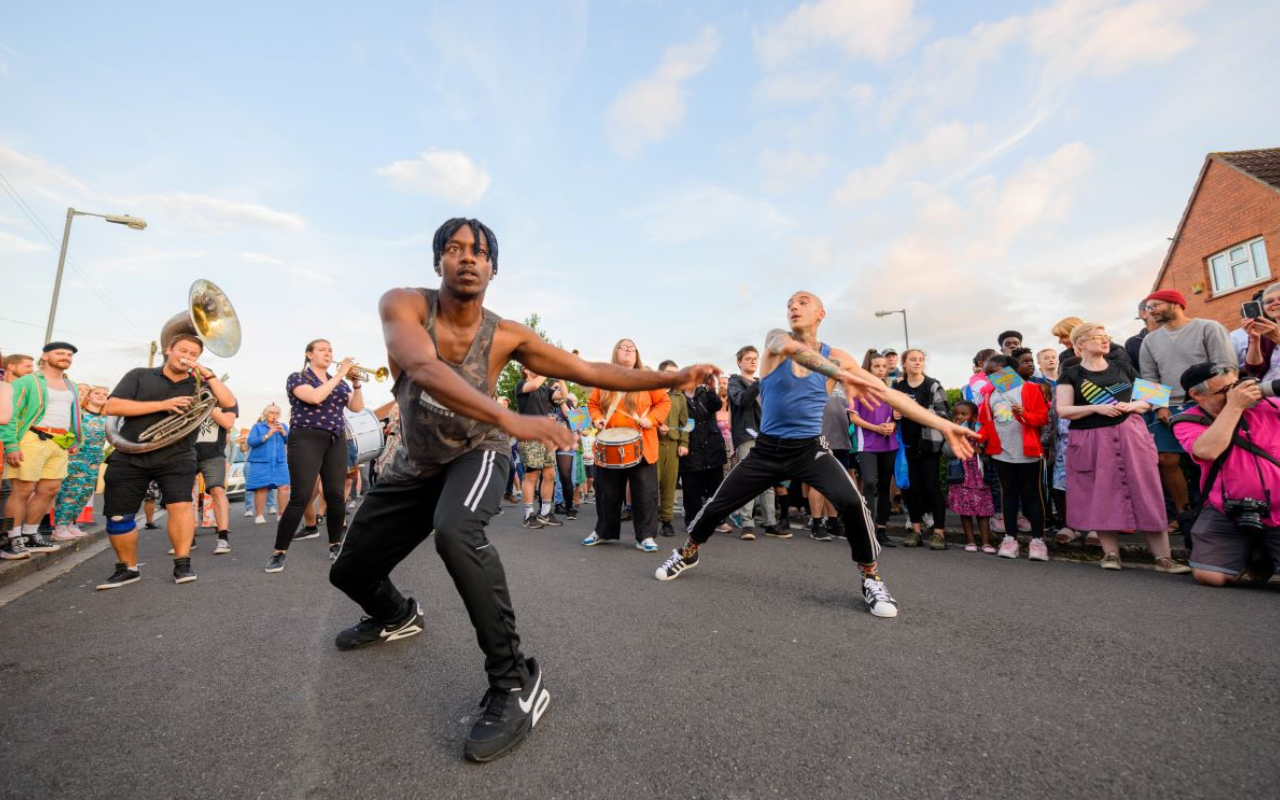
SMOOSH! perform at Knowle West, Bristol
Photo: Paul Blakemore
Reimagining the orchestra for the 21st century
Charles Hazlewood is on a mission to disrupt the traditional model of orchestral music and bring the excitement into the streets.
I have long dreamed of an open-air show where the divide between audience and artists disappears, where the audience are as much part of the show as the artists. One that is constantly on the move, where the live music is every karaoke track you ever desired, delivered by several pumping wind bands in perpetual motion like human jukeboxes.
This is SMOOSH! And next month Paraorchestra will be bringing it to the streets of Brighton and Hove as part of Brighton Festival. We cooked up the project during the first Covid lockdown as a safe and accessible way to bring live music to people stuck at home.
A cacophonous carnival making its way through residential streets, a troupe of dancers, and a whole community singing and dancing along in a massive karaoke – a massaoke. It’s the living embodiment of everything we stand for as an organisation. It’s bold, inclusive, and full of joy.
The evolution of the orchestra is painfully slow
Over the last ten years, Paraorchestra’s vision has been to throw out the rule book and revolutionise what an orchestra is. People have an expectation of orchestral music, and we aim to challenge that with every performance.
Each project presents something new and thrilling, seeking new ways for people to experience and engage with the music, and reaching the widest range of audiences as a result.
And we’re not limited by space either – there isn’t anywhere we can’t perform. We’ve been the only orchestral headliner on a Glastonbury mainstage, we’ve packed streets, nightclubs, arts galleries and concert halls – at every opportunity inviting audiences to literally climb inside our orchestra and experience a wholly immersive orchestral experience.
Yet it is unbelievable just how slow the evolution of the orchestra is – in terms of who has the opportunity to play or make the work, how it is presented, and who it is accessible to.
I’ve conducted hundreds of orchestras but, outside Paraorchestra, I haven’t met more than a handful of musicians with disabilities. There are huge access and attitudinal barriers to the industry for disabled people – something which we seek to be at the forefront of changing.
Music is the birth right of all
The orchestral model has become stuck: it is a custodian of a tradition. There have been no permanent new additions to the orchestra for at least 200 years – the last full-time instrument to enter the orchestra was the clarinet in the 1780s.
There is an old-school notion of what an orchestral performance is, with the audience sitting in serried ranks, the players separate, remote on a stage. And there’s still a barrier, that only a certain type of person, or a certain income bracket, invariably feels comfortable in a concert hall, content in that social milieu.
Music – and art in general – are about so much more than this. An orchestra is not a luxury for some; it is the birth right of all.
So, I asked myself: what if we reshaped that outdated – and ableist mould? And what if we removed the barriers that prevented people from performing at their best? What would we discover by nurturing a culture of inclusivity and equality, with adventure, openhearted collaboration and excellence? And what would happen is we placed it in contexts without rules; an environment for all?
Beyond levelling the playing field
38 members of our orchestra identify as disabled, D/deaf, or neurodiverse – a brilliantly diverse workforce, some of whom make music through unconventional means using assistive technology and digital portals.
We use this as a catalyst for embracing the whole sonic spectrum that’s emerged since the discovery of electricity: acoustic, analogue and digital instruments in joyous combination.
But our work goes beyond levelling the playing field for disabled musicians. We’re designing projects around the diverse qualities each musician brings. We have ambitions to create a fully-fledged artist development programme, providing unique and essential opportunities for our musicians to recognise themselves as artists.
The disabled musicians I have worked with have an unabashed brilliance, a sort of fearlessness not prevalent in the mainstream, and bring a rich tapestry of unique talents. We want to provide a space in which they can become the future leaders of the sector.
A show that arouses and inspires
At the point of performance, disability is irrelevant for performers and audiences. Of course, there’s a huge amount of work behind the scenes to ensure musicians can do their job, but we have proven beyond doubt that an inclusive approach yields dynamic, sensational, and world class results.
For every project – be it at WOMAD, a Sky Arts documentary, or in the streets of Brighton – the breadth, depth and quality of what we do, and the audacity of the ideas, is paramount. The goal is an impactful show that rouses and inspires. Music is a two-way experience, an act of love between the performers and the audience.
SMOOSH! embodies this, with the audience becoming part of the performance. We performed it for the first time in Bristol last autumn. Over 2,000 residents come out of their homes to follow the procession, singing, and dancing and experiencing the euphoria and joy of a shared musical experience.
We are gaining a reputation as a ground-breaking and paradigm-shifting ensemble. We are a 21st century orchestra reinventing what an orchestra is and how people engage with live music. A successful artistic organisation that reflects the diversity of society – surely that’s the model of the future for the arts.
Charles Hazelwood is Founder and Artistic Director of Paraorchestra.
Join the Discussion
You must be logged in to post a comment.